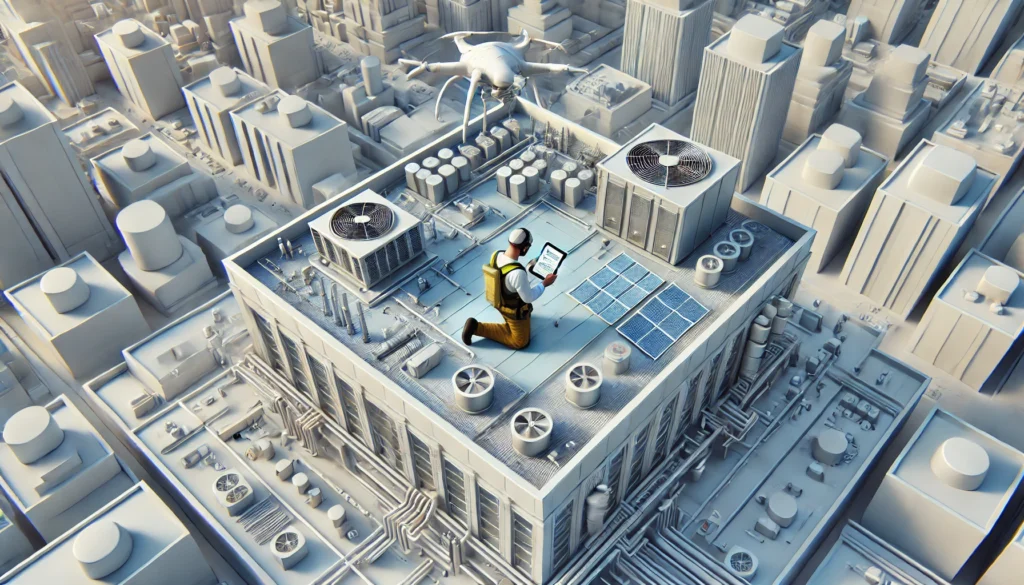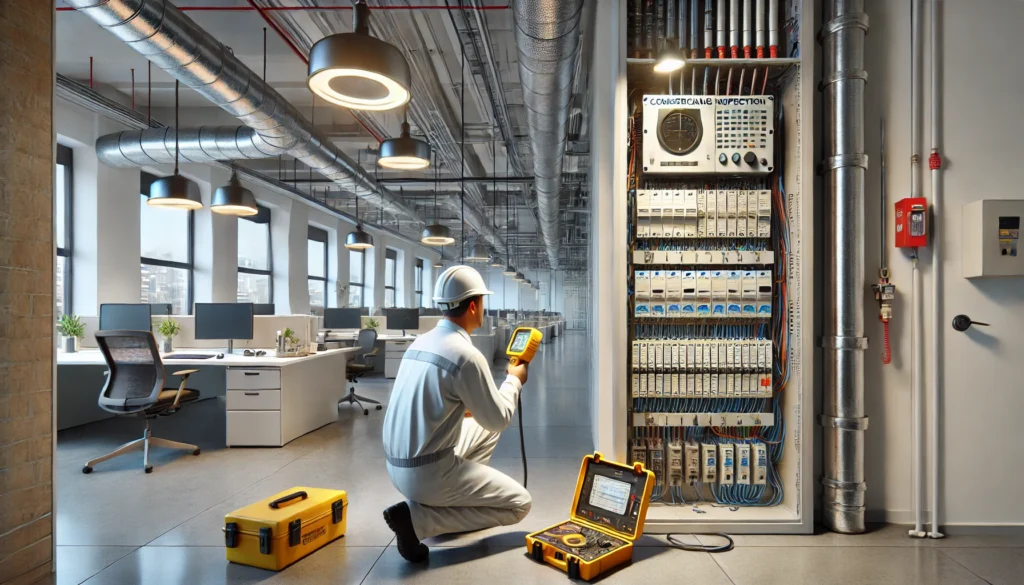Commercial building inspection is a vital process for ensuring the safety, functionality, and compliance of commercial properties. Whether you own, manage, or are planning to purchase a commercial building, regular inspections help identify potential issues, prevent costly repairs, and ensure the property meets regulatory standards. This guide provides a detailed overview of commercial building inspection, including the importance, key areas of focus, and the steps involved in conducting a thorough assessment.
1. Introduction to Commercial Building Inspection
A commercial building inspection is a comprehensive evaluation of a property’s condition, covering various components such as the structure, electrical systems, plumbing, HVAC (Heating, Ventilation, and Air Conditioning), and safety systems. These inspections are conducted by qualified professionals to ensure the building is safe, functional, and compliant with local regulations.
2. Importance of Commercial Building Inspection
Commercial building inspections are crucial for several reasons:
- Safety: Ensures that the building is safe for occupants, identifying hazards such as structural weaknesses, faulty wiring, or fire risks.
- Compliance: Confirms that the property meets building codes, safety regulations, and industry standards, avoiding potential legal issues.
- Maintenance: Identifies maintenance needs early, preventing minor issues from developing into costly repairs.
- Investment Protection: Provides valuable information for buyers, investors, and owners, helping them make informed decisions about the property’s value and required improvements.
- Insurance and Liability: Many insurance policies require regular inspections to assess risks and determine coverage.
3. Types of Commercial Building Inspections
Commercial building inspections can vary depending on the purpose and the building’s specific needs:
- Pre-Purchase Inspection: Conducted before purchasing a commercial property to identify potential issues and investment risks.
- Routine Maintenance Inspection: Regularly scheduled inspections to assess the building’s condition and address maintenance needs.
- Code Compliance Inspection: Ensures the building adheres to local building codes, safety standards, and regulations.
- Post-Repair Inspection: Conducted after repairs or renovations to verify that the work meets required standards and that the building is safe.
- Specialized Inspections: Focused inspections such as fire safety, environmental, or accessibility assessments to address specific concerns.
4. Key Areas of Focus in Commercial Building Inspection
A thorough commercial building inspection covers various aspects of the property:
Structural Integrity
- Foundation: Check for signs of settlement, cracks, or moisture intrusion in the foundation.
- Load-Bearing Elements: Inspect columns, beams, and load-bearing walls for cracks, deformation, or corrosion.
- Roof and Walls: Assess the condition of the roof for leaks, damage, or structural issues, and inspect exterior walls for signs of wear or damage.
Electrical Systems
- Wiring and Panels: Examine electrical panels, wiring, and connections for safety hazards, outdated components, or code violations.
- Lighting and Outlets: Check the functionality and safety of lighting fixtures, outlets, and emergency lighting systems.
- Safety Devices: Test smoke detectors, GFCIs (Ground Fault Circuit Interrupters), and other safety devices for proper operation.
Plumbing Systems
- Pipes and Fixtures: Inspect pipes, faucets, toilets, and drains for leaks, corrosion, and proper function.
- Water Heaters and Boilers: Evaluate the condition and efficiency of water heaters, boilers, and related equipment.
- Water Quality: Test for water quality issues such as contamination, pressure, and temperature consistency.
HVAC Systems
- Heating and Cooling Units: Assess the performance and condition of heating and cooling systems, including furnaces, air conditioners, and ventilation.
- Ductwork and Insulation: Check ductwork for leaks, blockages, or poor insulation that may affect energy efficiency and air quality.
- Thermostats and Controls: Test thermostats and control systems for accurate temperature regulation and energy management.
Fire Safety and Emergency Systems
- Fire Alarms and Sprinklers: Verify the proper installation, operation, and maintenance of fire alarm systems and sprinkler systems.
- Emergency Exits and Lighting: Ensure that emergency exits are accessible, clearly marked, and equipped with functional lighting.
- Fire Extinguishers and Suppression Systems: Check the availability, condition, and compliance of fire extinguishers and other fire suppression systems.
5. Steps to Conduct a Commercial Building Inspection
A commercial building inspection involves the following steps:
1. Pre-Inspection Planning
Define the scope of the inspection, considering factors such as the building’s age, size, and usage. Gather relevant documents, including building plans, maintenance records, and previous inspection reports.
2. Exterior Inspection
Begin with an exterior inspection, assessing the building’s facade, roof, foundation, and surrounding areas for visible signs of damage or wear.
3. Interior Inspection
Move inside to examine structural elements, electrical systems, plumbing, HVAC, and safety systems. Use specialized equipment for detailed assessments, such as thermal imaging for insulation and moisture detection.
4. System Testing
Test the building’s systems, including electrical, plumbing, HVAC, fire alarms, and emergency equipment, to ensure they are functional and meet safety standards.
5. Documentation and Reporting
Document findings with photographs, measurements, and detailed notes. Generate a comprehensive inspection report outlining the condition of the building, identified issues, and recommended actions.
6. Post-Inspection Review
Review the inspection findings with stakeholders, discussing any concerns, potential repairs, or further assessments needed.

6. Common Issues Found in Commercial Buildings
Commercial building inspections often reveal common issues, such as:
- Roof Leaks and Damage: Water infiltration through the roof, leading to interior damage and mold growth.
- Electrical Hazards: Outdated wiring, overloaded circuits, and faulty electrical panels posing fire risks.
- Plumbing Leaks: Leaking pipes, fixtures, or water heaters resulting in water damage and increased utility costs.
- HVAC Inefficiencies: Poorly maintained HVAC systems causing reduced efficiency, higher energy costs, and inconsistent climate control.
- Structural Cracks: Cracks in walls, foundations, or load-bearing elements indicating potential structural issues.
- Fire Safety Violations: Non-compliant fire alarms, sprinkler systems, and emergency exits compromising occupant safety.
7. Pro Inspect Solution: Your Partner for Commercial Building Inspections in Malaysia
For professional commercial building inspections in Malaysia, Pro Inspect Solution offers comprehensive services to ensure your property is safe, compliant, and well-maintained. Their services include:
- Comprehensive Inspections: Detailed assessments of all building components, including structural, electrical, plumbing, HVAC, and safety systems.
- Advanced Testing Methods: Utilizing state-of-the-art equipment for accurate detection of hidden issues such as moisture, thermal leaks, and electrical hazards.
- Regulatory Compliance: Ensuring that your building meets local building codes, safety regulations, and industry standards.
- Customized Reports: Providing clear and detailed inspection reports with actionable recommendations for repairs and maintenance.
Partnering with Pro Inspect Solution ensures your commercial building remains in optimal condition, safeguarding your investment and ensuring occupant safety. Learn more about their services at Pro Inspect Solution.
8. Commercial Building Inspection FAQs
What is maintenance for a commercial building?
Maintenance for a commercial building involves routine tasks such as cleaning, repairs, and servicing of various building systems like HVAC, electrical, plumbing, and fire safety. This ensures the building remains safe, functional, and in compliance with regulations.
What is the facility inspection process?
The facility inspection process is a systematic evaluation of a building’s condition, covering structural, mechanical, electrical, and safety systems. It involves checking for damage, wear, and compliance with safety codes to ensure the facility is safe and operational.
What is visual inspection of a building?
Visual inspection of a building is a non-invasive examination of the property’s physical condition. Inspectors look for visible signs of damage, such as cracks, leaks, and corrosion, to identify potential issues that may affect the building’s integrity.
What are the types of visual inspection?
Types of visual inspection include routine inspections, detailed inspections, and specialized inspections. Routine inspections are general checks, detailed inspections involve thorough examination of specific areas, and specialized inspections focus on particular systems like electrical or HVAC.
What is commercial facility maintenance?
Commercial facility maintenance involves the upkeep of a commercial building’s infrastructure, including repairs, servicing of equipment, cleaning, and safety checks. Its goal is to ensure the building operates efficiently, remains safe, and provides a comfortable environment for occupants.
What is the general maintenance of a building?
General maintenance of a building includes routine tasks such as cleaning, painting, minor repairs, and servicing of systems like HVAC, plumbing, and electrical. It aims to preserve the building’s appearance, functionality, and safety over time.
9. Conclusion
Commercial building inspections are essential for ensuring the safety, functionality, and compliance of properties. By covering key areas such as structural integrity, electrical and plumbing systems, HVAC, and fire safety, these inspections provide valuable insights into a building’s condition. For comprehensive commercial building inspection services in Malaysia, Pro Inspect Solution offers the expertise and advanced technology needed to protect your investment and ensure occupant safety.


